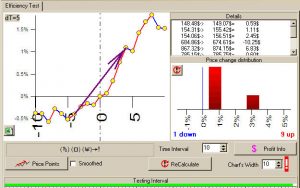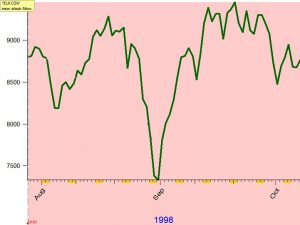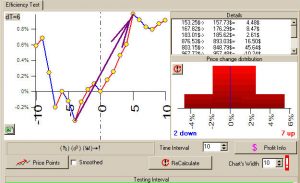Can we really predict the Dow Jones utilizing only one aspect between a pair of the planets?
by Alphee Lavoie
I remember that in 1998 many Astro financial astrologers were predicting a major down for October, basing their judgment on the transit of Saturn square to transiting Neptune on October 31 of that year. This square had already occurred on June 25,1998 and would not occur again until April 6, 1999.
Equipped with my Market Trader software program, I immediately employed the efficiency testing module to find out what happened in the past with this important square. The following graph shows exactly what occurred from 1928. It didn’t look really promising to bring a major down.

Under that aspect the major moves were up 9 times and down 1 time.
Next I used the BlackBox module in Market Trader to educate the computer and create a forecast for August and September of 1998. The following graph shows that forecast.

After the fact we saw that this so-called violent aspect didn’t bring the stock down but , instead, brought the Dow Jones up 6.57%. This result is more within the parameters of the probability of what that aspect produced in the past.

In the middle of August CNN wanted me to go to New York to be on their financial show. After telling them that I would not travel to New York they decided to come to West Hartford to interview me. They wanted to hear my opinions about that celestial square and why astrologers were certain that it would create a major down.
At that point I told them that the major down for the year would be in the last week of August.
The Hartford Courant, the largest newspaper in Ct, saw me on CNN and was prompted to write an article about me and my prediction for the August market. They also interviewed major trading firms from Boston (which I will not mention here but were named in their article) who negated the science of astrology, dissed astrologers and stated that following the advice of astrologers would make you lose your shirt!
However, I had the last laugh a couple of months after this major down in August as these huge financial firms announced that they were closing many offices across the country.
Right after this happened I realized that it’s almost next to impossible to properly forecast the market on one aspect with a planetary pair. There are just too many things going on in the sky at the same time.
The classical astrological aspects work exceptionally well in psychological application, but that doesn’t necessarily mean that they would have the same effect in market prediction.
That’s when my partner, Sergey, and I decided to come up with a solution to have the ability to analyze market movement using every opening (in degrees or in minutes) between a pair of planets.
The proof is in the pudding because that has been working very well for me and many of our owners of our Market Trader software.
In February 28, 2007 transiting Saturn was going to make the aspect of an opposition to the planet Neptune. Again Astro financial astrologers were predicting a major down. If we look at the probability of that aspect with our efficiency testing module since 1928, this is what it looked like. The graph shows that the Dow has a strong probability of going up.

In November 2006 I posted this following forecast graph on my website for the month of February 2007. Again this forecast was calculated using past performance of the Dow Jones and the Market Trader Software’s artificial intelligence to educate the computer by using every degree and minute between all pairs of planets in transit.

Now this forecast shows major down on that aspect. And, lo and behold, it beats the odds of seven to two and it went down.
The big question that needs to be asked is this: was Saturn oppose Neptune the only astrological energy to caused that down or was that down caused by many other aspects happening at the same time? When we look at the efficiency testing we see that in the past when Saturn opposed Neptune it produced a majority of upswings. So why did it produce a downswing this time? If cycles or probability repeats this aspect would have been an upswing.
There are a lot of activities occurring in the sky concurrently that effect the market. Among other things, one of these factors could be the position of the Moon. In February 2007 Saturn/Neptune aspected the Moon in the sign of Cancer. The following graph indicates that since 1928 the Moon in the sign Cancer makes the Dow Jones fall. In October of 1998 the Moon was the sign Pisces, showing strength in the Dow Jones .

I don’t believe that you can predict the market with one classical aspect between a pair of planets. There are many other modules that I can use in the market trader software to prove this point. I also question whether the market moves on the Ptolemy aspects. Take a look at the next diagram.

This was produced by examining the Sun Pluto opening since 1928. Notice the peak is at 103° opening and the bottom is at 283 degree opening. This aspect of the square produced a top and bottom of 13° after the exact Ptolemy classical square aspect. For the Sun’s movement that’s 13 days after the square.
My choice is to put my money on degrees and seconds of the opening between pairs the planets instead of using classical aspects.
In the early 90’s I introduced the different results between a waxing and waning square or any aspect for that matter. I called it ‘back and front’ because trying to explain it to a non-astrologer in astrological terms was unclear. But when I used the phrase ‘back and front’ they got the concept right away. 90° is the front square while 270° is the back square. 60 degrees is the front sextile and 300 is the back sextile. Every aspect, except the conjunction and opposition, has a ‘front and back’ degree to it. In the following diagram front sextiles bring tops and the back sextiles portend bottoms. This is why we have to be careful when we’re talking about aspects.

As you can see aspects bring a different meaning to the market.
Copyright 2008, Air Software